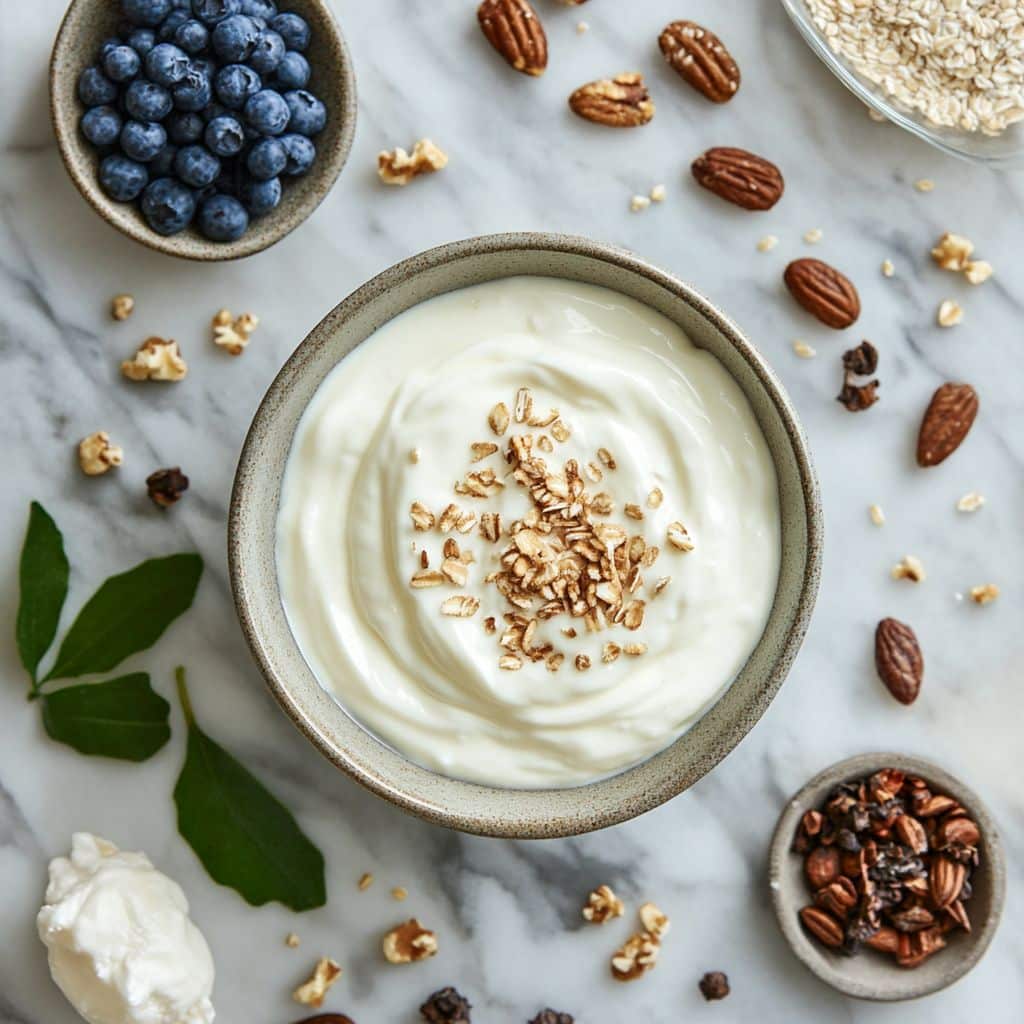
Keto yogurt has earned its spot in the low-carb world, but not every yogurt belongs on your ketogenic plate. If you’ve ever stared at the dairy section wondering what fits and what ruins ketosis, you’re not alone. Whether you’re tracking every gram of carb or just trying to make smarter choices, understanding which yogurts support a keto lifestyle can make all the difference. In this article, we’ll cover everything from picking the right yogurt to customizing it with keto-friendly toppings. Plus, you’ll find tips that tie into other low-carb favorites like keto pasta and carnivore-style recipes to round out your meals.
What Makes Yogurt Keto-Friendly
Low-Carb Yogurt: What to Look For
I remember the first time I had to skip my usual morning yogurt after starting keto. The label looked innocent enough—”plain,” “natural”—but when I turned it over, the sugar content made me drop it right back on the shelf. Not all yogurts are created for a low-carb lifestyle. A proper keto yogurt contains minimal sugar, full fat, and no unnecessary additives. The goal is to find options that offer protein and probiotics without sneaking in hidden carbs. Look for unsweetened plain Greek yogurt or better yet, coconut or almond-based varieties with no added sugar. Many people also turn to cottage cheese for a similar texture and high-fat profile, like in this cottage cheese taco bowl recipe.
When shopping, keep an eye out for total carbs. Aim for yogurts with under 6g net carbs per serving. Greek-style or Icelandic skyr are often more concentrated in protein and less in lactose, making them safer choices for your macros. Bonus tip: if you’re meal-prepping other low-carb dishes like keto peanut butter cookies, save some for breakfast pairing with yogurt to keep things exciting.
Full-Fat vs Low-Fat: Which is Better for Keto?
Many of us grew up thinking low-fat was the healthy route, but keto turns that on its head. Full-fat yogurt is the only kind that fits. You need that fat to fuel your body in the absence of carbs. Low-fat yogurts tend to increase sugar content to make up for lost flavor—and that’s a keto no-go. Instead, full-fat versions satisfy longer and help keep your energy steady. It’s the perfect ingredient for snack bowls, sauces, or even savory dips.
If you’re looking for more full-fat, keto-supportive ingredients, our how to make cottage cheese taco bowl guide includes fat-rich combinations perfect for the same meal planning mindset.

Table of Contents
ToggleCoconut and Dairy-Free Keto Yogurt
Coconut Yogurt on Keto: A Smart Swap
When following keto, regular yogurt often leads to unexpected sugar intake. That’s where keto yogurt made from coconut milk becomes a game-changer. It’s naturally high in fat and dairy-free, but you’ve got to read the label closely. Many commercial coconut yogurts sneak in sweeteners, fruit purees, or added starches that can raise net carbs dramatically. What you want is an unsweetened version made with clean, simple ingredients.
Once you find a good one, the uses are endless. You can add it to your breakfast alongside a carnivore-friendly dish or scoop some next to roasted veggies or keto pasta for a creamy, satisfying touch without spiking your blood sugar.
DIY Keto Yogurt: Made Your Way
If you’re tired of playing ingredient detective at the store, there’s a better route: make your own. Homemade keto yogurt lets you skip added sugars, preservatives, and fillers completely. All it takes is one can of full-fat coconut milk and a single probiotic capsule. Combine them, leave the mixture covered in a warm place for 24–36 hours, and voilà—you’ve got your own dairy-free keto yogurt.
It’s rich, tangy, and tailored to your macros. You can even use heavy cream for a dairy version if that suits your plan. Once chilled, this yogurt makes a perfect topping for savory bowls like the cottage cheese taco bowl or as a spread with low-carb wraps and meats, similar to dishes in this Instant Pot chicken guide.
Print
Keto Yogurt: Best Choices, Sweeteners & Dairy-Free Options
5 Stars 4 Stars 3 Stars 2 Stars 1 Star
No reviews
Creamy, low-carb keto yogurt made with coconut milk or cream, perfect for breakfasts or snacks on a ketogenic diet.
- Total Time: 1440
- Yield: 2 cups 1x
Ingredients
1 can full-fat coconut milk
1 probiotic capsule
1/2 tsp vanilla extract (optional)
Liquid stevia to taste
Instructions
1. Shake coconut milk to combine contents.
2. Pour into a clean glass jar.
3. Open probiotic capsule and stir contents into the milk.
4. Cover with a breathable cloth and leave at room temperature for 24–48 hours.
5. Refrigerate before serving. Stir well before use.
Notes
Use only unflavored, additive-free probiotic capsules.
Fermentation time may vary with room temperature.
Flavor after fermenting—not before—for best results.
- Author: Tiramisu Cake
- Prep Time: 5
- Category: Keto Recipes
- Method: No-Cook
- Cuisine: Low-Carb
Nutrition
- Serving Size: 1/2 cup
- Calories: 160
- Sugar: 1g
- Sodium: 10mg
- Fat: 14g
- Saturated Fat: 12g
- Unsaturated Fat: 2g
- Trans Fat: 0g
- Carbohydrates: 3g
- Fiber: 1g
- Protein: 2g
- Cholesterol: 0mg
Sweetening and Flavoring Keto Yogurt Naturally
How to Sweeten Keto Yogurt Without Sugar
You don’t need refined sugar to enjoy yogurt on a ketogenic diet. In fact, most sweeteners from the regular aisle can throw you out of ketosis fast. Instead, reach for low-carb options like stevia, erythritol, or monk fruit sweetener. These won’t impact your blood sugar and blend easily into thick, tangy keto yogurt. Try a few drops of liquid stevia if you’re short on time—it stirs in quickly and doesn’t leave a gritty texture.
Want something with more bite? Mix in cinnamon, vanilla extract, or even a touch of nutmeg for warm flavor notes without carbs. This combo works beautifully with a base like keto peanut butter cookies, crumbled on top for a satisfying snack that feels like dessert but fits your macros.
Keto Yogurt Flavor Ideas You’ll Actually Love
Keto yogurt doesn’t have to be plain or boring. Try adding a spoonful of chia seeds and let it sit for 10 minutes—they plump up and create a pudding-like texture. For crunch, go with unsweetened coconut flakes, crushed walnuts, or pumpkin seeds. Fresh berries in moderation—especially raspberries and blackberries—offer natural sweetness without going over your daily carb limit.
If you’re in the mood for a meal-prep-friendly treat, you can layer yogurt in small jars with your favorite keto toppings. They store well and save time in the morning. Want more meal-prep ideas? Recipes like frozen chicken breast in Instant Pot and chicken quesadilla offer the same plan-ahead flexibility for savory meals.
Keto yogurt becomes way more exciting when it matches your flavor preferences and keeps carbs low. With the right mix-ins, it’s easy to turn a plain base into something indulgent and still totally keto-compliant.
Best Yogurt Types for Keto (and What to Avoid)
Top Yogurts That Fit a Ketogenic Diet
When you’re following a ketogenic lifestyle, not all yogurts are off-limits. The key is knowing what to choose. Unsweetened Greek yogurt is one of the best store-bought options—it’s thick, high in protein, and has less lactose than traditional yogurt. Icelandic yogurt (Skyr) is another strong choice, though it’s slightly lower in fat. If you’re dairy-sensitive, coconut milk yogurt—as we covered in Part 2—is a safe and creamy alternative. Always pick the versions with no added sugars or fruit flavoring.
A great habit? Pair these yogurts with savory ingredients. Stir in herbs, olive oil, and garlic to turn your yogurt into a creamy sauce or dip—perfect alongside meals like Instant Pot chicken or served as a base in a bowl like our cottage cheese taco bowl.

What to Avoid: Yogurts That Can Kick You Out of Ketosis
Flavored yogurts might seem healthy, but they often come with more sugar than a candy bar. Even “low-fat” or “light” yogurts tend to sneak in hidden carbs to improve taste. One small cup of fruit-on-the-bottom yogurt can pack 15–20g of sugar—enough to stall fat-burning for hours. Skip anything with honey, cane juice, or corn syrup on the ingredient list.
Also, beware of misleading labels like “organic vanilla” or “natural fruit swirl.” These sound wholesome but usually don’t align with keto macros. If you’re craving something fruity, add your own chopped berries to plain yogurt instead. Or, enjoy your yogurt with one of our chicken ham meals to get a salty-sweet balance that satisfies both cravings.
When in doubt, go with full-fat, plain yogurt and build flavor yourself. That’s how you stay in ketosis—and actually enjoy it.
FAQ : Keto Yogurt Questions Answered
What yogurt is suitable for a ketogenic diet?
The best yogurts for keto are full-fat, unsweetened, and low in carbohydrates. Greek yogurt, plain coconut yogurt, and even homemade versions made from heavy cream or coconut milk are excellent choices.
Can you eat whole milk yogurt on a keto diet?
Yes, whole milk yogurt is actually preferred on keto. It’s higher in fat and typically lower in sugar than low-fat or flavored versions, helping you stay full longer and maintain fat intake.
Is coconut yogurt keto-friendly?
Absolutely—if it’s unsweetened. Coconut yogurt is naturally dairy-free and rich in healthy fats, making it a great alternative for those avoiding dairy while staying low-carb.
How do you sweeten yogurt on keto?
Use keto-approved sweeteners like stevia, erythritol, or monk fruit. You can also mix in a bit of vanilla extract, cinnamon, or unsweetened cocoa powder for added flavor without increasing carbs.
Conclusion
Keto yogurt doesn’t just have a place in your low-carb lifestyle—it can become one of its best staples. By choosing full-fat, unsweetened options and flavoring them naturally, you keep things tasty and satisfying without blowing your carb count. Whether you buy it or make your own, keto yogurt fits into breakfasts, snacks, and even savory dishes. Want more keto inspiration? Try pairing your yogurt creations with chicken-based Instant Pot meals or keep it simple with a low-carb, high-fat taco bowl. Delicious doesn’t have to mean complicated—especially on keto.




